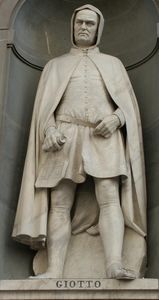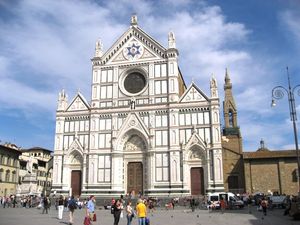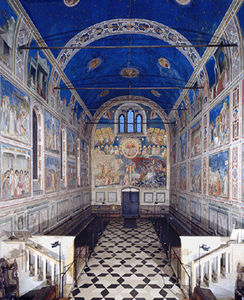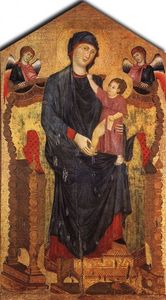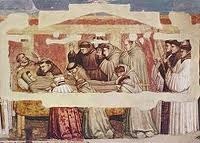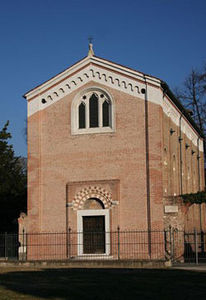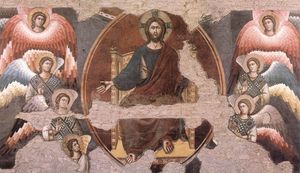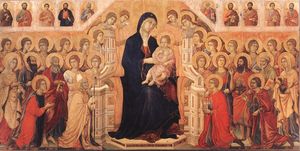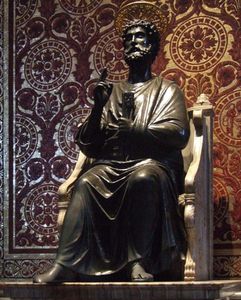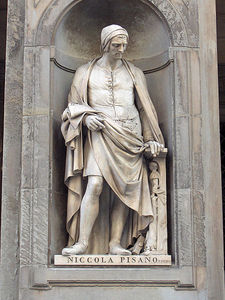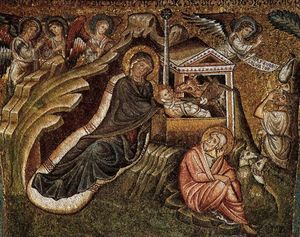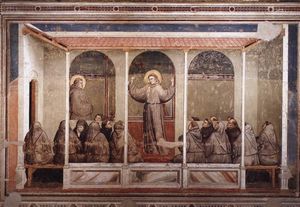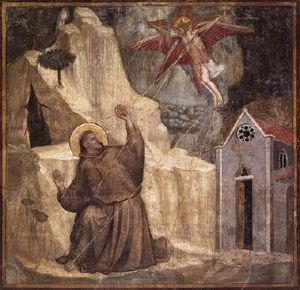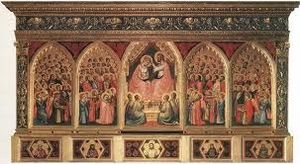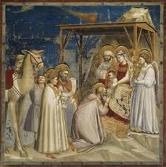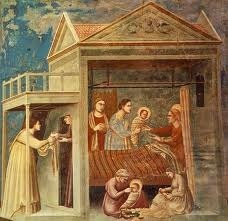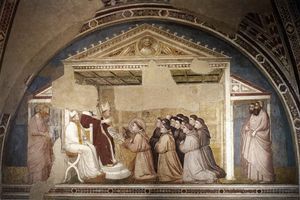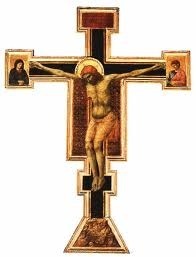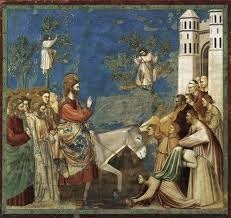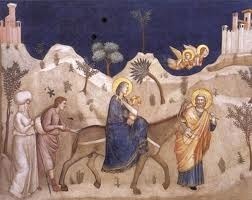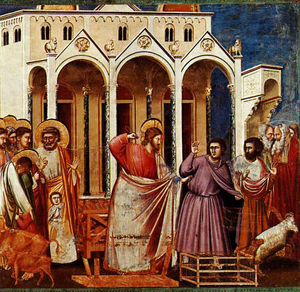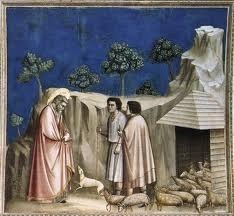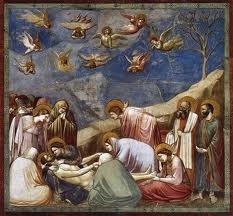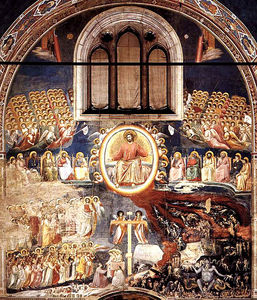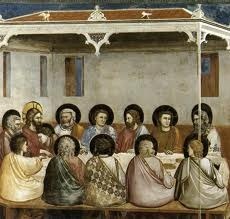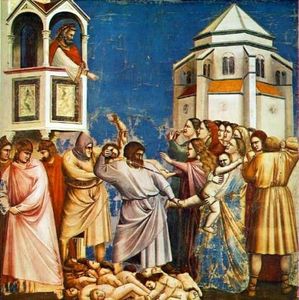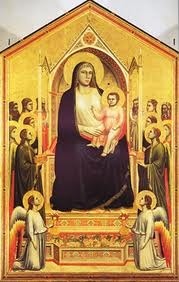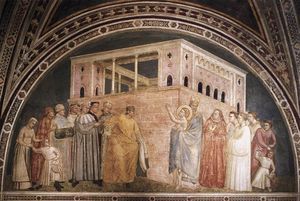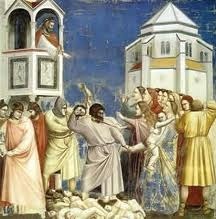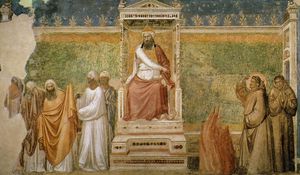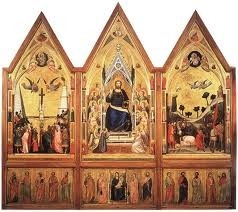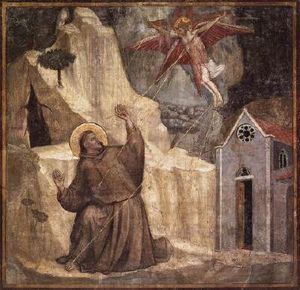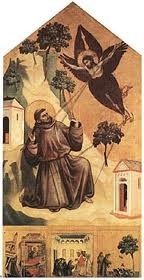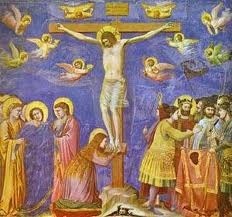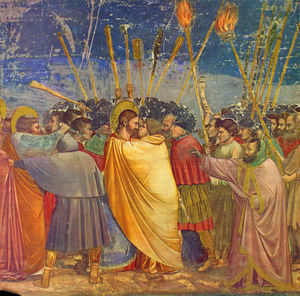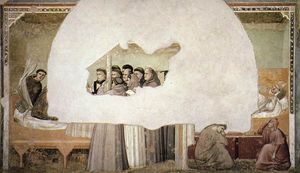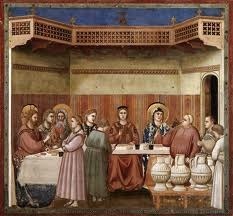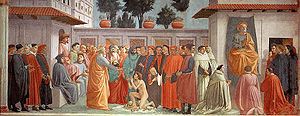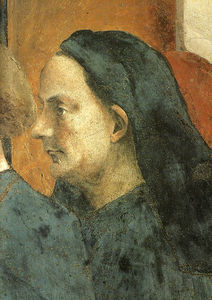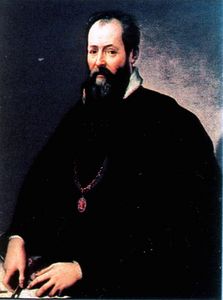Giotto di Bondone
- Short Name:
- Giotto
- Date of Birth:
- 1266
- Date of Death:
- 1337
- Focus:
- Paintings
- Mediums:
- Tempera, Wood
- Subjects:
- Figure, Landscapes, Scenery
- Art Movement:
- Renaissance
- Hometown:
- Florence, Italy
- Giotto di Bondone Page's Content
- Introduction
- Biography
- Style and Technique
- Who or What Influenced
- Works
- Followers
- Critical Reception
- Bibliography
Introduction
A strikingly talented painter from childhood, Giotto di Bondone spent his career focusing almost exclusively on frescoes that later influenced the likes of Masaccio, Michelangelo and Raphael. Di Bondone is often credited with being the father of the Renaissance for his devotion to physical and emotional accuracy in portraying humans, almost always saints and other religious figures.
Di Bondone was apprenticed at a very young age and spent his life working throughout Italy but primarily in Florence. He worked in the very earliest part of the Renaissance and was the first artist to break away from Byzantine styles and move toward naturalism and a clear sense of space.
Di Bondone's ultimate gift to the Renaissance was his unparalleled grasp of human emotion, which he was able to transfer in astoundingly accurate detail onto his work. Though his authorship is sometimes doubted due to lack of records, it is certain that di Bondone is responsible for the Stefaneschi Triptych, the Ognissanti Madonna and the Santa Croce Chapels in Florence.
However, his most famous work is the Scrovegni Chapel (often called the Arena Chapel) in Padua. Although very few of di Bondone's works have survived, his catalyst role in the Renaissance is indisputable.
Giotto di Bondone Biography
Early years:
Little is known about Giotto di Bondone's family and personal life, but it is commonly accepted that he was born around 1266 in the village of Vespigano, Italy. He showed astonishing talent at a very young age and is said to have been apprenticed to the great Florentine painter Cimabue.
Legend has it that Cimabue asked permission from di Bondone's father to take young Giotto as an apprentice after seeing his startlingly life-like rock drawings of sheep.
Middle years:
Di Bondone spent his apprenticeship exploring Italy with his master and his reputation spread like wildfire, eventually prompting the poet Dante to praise him in verse, cryptically opining that he had far surpassed his master, Cimabue.
A happy and intelligent man, di Bondone, who fathered six children, had great wit and loved practical jokes. It is said that when a Pope's messenger arrived at di Bondone's house one day to request proof of his genius, he simply drew a perfect, red circle - in one stroke - and sent the messenger back.
Di Bondone's earliest known works, a series of frescoes (paintings on fresh, still-wet plaster) on the life of St. Francis in the church of Assisi, were completed in the mid-1290s. He executed his masterwork, the Scrovegni Chapel, in 1305.
Throughout his middle years di Bondone's fame grew exponentially, attracting the attention and eventual friendship both of the Pope and King Robert of Naples.
Later years:
Di Bondone enjoyed a successful but relatively uneventful life in Italy though he had many friends and associates in the art world. In 1334, three years before his death, the city of Florence designated him Magnus Magister (Great Master) and appointed him head Florentine architect and chief of public works. He was in the middle of building the Campanile ('Giotto's Tower') in Florence when he died, and his successor and ardent follower, Andrea Pisano, assumed control of the building.
Di Bondone was a very wealthy, famous and successful artist when he died in 1337. He left behind all six children and an invaluable artistic foundation on which it is commonly believed that the Renaissance was built.
Giotto di Bondone Style and Technique
Early years:
Giotto di Bondone was almost completely self-taught; born into the midst of such painters as Pietro Cavallini and the great Duccio, he had at his disposal some of the greatest known late Medieval works.
Although apprenticed to a master who stringently adhered to a solidly Medieval style of painting, incorporating both the Gothic and Byzantine, Giotto's style evolved as much less stylized and elongated than that of Cimabue.
His early career was characterized by experimentation with tighter-than-normal brush strokes to create more realistic-looking subjects; his first known works, the frescoes on the life of St. Francis at the church of Assisi, are clear evidence of this technique.
Middle years:
Di Bondone continued to revise and refine his approach to representational painting throughout his career. It is even said that representational art found its highest expression at his hands.
Di Bondone chose to paint his subjects, the overwhelming majority of which were religious figures, in a solid and classicizing way reminiscent of Arnolfo di Cambio. Indeed, his masterpiece, the Scrovegni Chapel, is evidence of as much: di Bondone used meticulously sculpted subjects within compact spaces, along with naturalistic elements in all of the Chapel.
He also pioneered a unique style of painting in which the subjects are arranged in such a way as to make the viewer appear to have a place in the painting. This was a huge step away from the often distant tones of art in the Medieval period.
Later years:
As di Bondone grew older, his subjects remained consistently religious in nature, but his style continued to develop. Toward the end of his life, he was commissioned to paint the Santa Croce Chapels in Florence. One chapel in particular, the Peruzzi Chapel, became especially renowned during Renaissance times for di Bondone's ingenious use of chiaroscuro and his masterful manipulation of perspective.
In the frescoes from this period that survived, it is clear that di Bondone's style had become more ornate, possibly as a result of the influence of the fledgling International Gothic Style.
Who or What Influenced Giotto di Bondone
The Marmorarii:
Although Giotto was widely considered a pioneer in his adherence to naturalism, choosing to move away from traditional Byzantine stylizations, he took his cue from other Italian painters of the school of the Marmorarii.
The artists of this illustrious school included painters Nicolò Pisano, Pietro Cavallini and Duccio, along with mosaic-worker Jacopo Torriti. It is often said that while these artists initiated a return to naturalism and a focus on the beauty of the real human form, both found their highest expression in di Bondone.
The Church:
Di Bondone lived and worked in Italy, the cradle of Catholic civilization, and his subjects were almost exclusively religious figures, such as saints, popes and angels.
It is not known whether di Bondone was especially devout, but his frescoes are found only in Catholic houses of worship, suggesting that he could have been deeply religious.
He was in high demand by churches and cathedrals throughout Italy for most of his life, having demonstrated time and again his unique ability to capture authenticity in the human face and body and apply it to his subjects.
Giotto di Bondone Works
Giotto di Bondone Followers
As Giotto di Bondone is considered, in effect, the father of the Renaissance, it is impossible to list all of the artists who eventually followed his pioneering style and technique. However, it is certain that many High Renaissance masters studied his works and were influenced by him.
The vast majority of the works of his contemporaries and the generation following di Bondone also show unmistakable evidence of his heavy influence.
During life:
It is often said that no other single painter has ever duplicated the impact that di Bondone made on his age. The school of the Giotteschi was prolific and astonishingly homogeneous, featuring the likes of Taddeo and Agnolo Gaddi, Orcagna, Spinello and numerous others.
Giotto took the slowly-evolving style of medieval times and virtually single-handedly accelerated it into the birth of the fully-fledged Renaissance. His immense popularity during his lifetime is probably responsible for much of this influence.
Di Bondone was very highly regarded, from laypeople to the King of Naples, making his contemporaries eager to imitate his style. Many of Florence's wealthiest families are said to have commissioned his work on a number of occasions, most notably the Santa Croce Chapels of Peruzzi, Bardi, Giugni and Tosinghi Spinelli. Di Bondone became Florence's city architect in 1334, further evidence of his mass appeal.
After death:
Di Bondone's work continued to influence the generations that following him to varying degrees. By the time of the International Gothic movement, his influence had subsided considerably but was still studied by the up-and-coming artists of the Renaissance.
Italian masters Michelangelo, Raphael and Masaccio are all known to have studied and been influenced by di Bondone, especially evident in Michelangelo's work on the ceiling of the Sistine Chapel.
It can also be said that di Bondone was the father of what is today known as humanism, or an emphasis on humanity in art. His reverence for humans and the human form, and his fondness for truly reproducing human gestures and emotions in his work, was inherited and repeatedly imitated by countless artists succeeding him.
Giotto di Bondone Critical Reception
Giotto di Bondone enjoyed immense popularity, appealing throughout his life to everyone from the peasantry to the Pope himself. The art world welcomed his transformation of the highly stylized Medieval methods into something more human and authentic; indeed, his ideas and techniques were copied even during his lifetime by numerous artists.
During life:
Early years:
As a young boy and an apprentice, and indeed throughout his life, Giotto di Bondone was jovial, intelligent and well-liked. His art was immediately well-received and his earliest known work, the frescoes of the church of St. Francis in Assisi, were lauded throughout Italy for its startling realness.
Although his extraordinarily unique humanist style was still evolving as an apprentice, many believed Giotto would soon eclipse his master in popularity and eventually, he did just that.
Middle years:
As di Bondone's career progressed, his commissions increased exponentially, so popular was his emotional, individualized approach to painting.
Only three of his works have survived intact but records from the time indicate that he was much in demand by all of Italy. During his thirties and forties, at the height of his popularity, he received widespread acclaim from the literary community and was named an accomplished portraitist by author Pietro d'Abano. Furthermore, he was singled out for praise for his other works by writers Francesco da Barberino and Riccobaldo, as well as the poet Dante.
Later years:
Dante's tribute secured di Bondone's reputation and his wealth and fame continued to grow into the latter years of his life.
In the late 1320s, he was commissioned by four wealthy Florentine families to decorate four family chapels (Peruzzi, Bardi, Giugni and Tosinghi Spinelli) in Santa Croce. A little later, in 1328, he received an invitation from King Robert of Naples. He accepted and stayed in the royal household for over five years, going back to Florence only when Florentine civic officials begged him to return.
Di Bondone was granted the title of Florence's head of public works upon his return. The document establishing di Bondone's new office stated "There is no one in the whole world more qualified in these and many other matters than Giotto di Bondone."
After death:
14th Century:
Di Bondone's fame and mass appeal continued well into Italy's next generation of painters. His immediate successors were his students, Taddeo and Bernardo Gaddi, who assumed control of the Campanile (Giotto's Tower) when he died in 1337.
Upon his death, di Bondone was buried in the Cathedral of Santa Reparata, which attested to his exalted position in Florence. The Renaissance, with di Bondone's help, was just getting started in the fourteenth century, and many of the future masters studied his frescoes intensively and later imitated his humanist, emotional style.
15th Century:
It took another generation or so before di Bondone's techniques were fully appreciated by the art world at large. The most noteworthy artistic shift of the fifteenth century was a movement toward realistic perspective. Di Bondone had begun this as early as the late thirteenth century, but it was not fully adopted as a formal technique (and used as a yardstick by which an artist's skill was measured) until it was popularized by architect/sculptors Filippo Brunelleschi and Leon Battista Alberti.
As di Bondone had done throughout his life, numerous artists quickly caught on and began applying this technique to light and shadow as well.
16th Century:
Respect for di Bondone's contributions to the Renaissance did not flag in the sixteenth century, but the art world was steadily moving into the International Gothic style. While it can certainly be said that Giotto heavily influenced many of the greatest masters in history (it is known that Masaccio, Michelangelo, and Raphael studied and imitated to some extent di Bondone's techniques), art trends were shifting once more. During the sixteenth century, chronicler Giorgio Vasari wrote of di Bondone "Giotto obscured the fame of Cimabue, as a great light outshines a lesser."
Giotto di Bondone Bibliography
To learn more about Giotto and his artworks please choose from the following recommended sources.
• Derbes, A. & Sandona, M. The Cambridge Companion to Giotto. Cambridge University Press, 2004
• Eimerl, Sarel. The World of Giotto, C. 1267 - 1337. Little Brown & Company, 1967
• Norbert, Wolf. Giotto di Bondone. Taschen, 2000
• Richardson, Carol M. , et al. Renaissance Art Reconsidered: An Anthology of Primary Sources Wiley-Blackwell, 2006
• Paolettii, John T. & Radke, Gary M. Art in Renaissance Italy. Laurence King, 2005
• Nichols, Tom. Renaissance Art: A Beginner's Guide. Oneworld Publications, 2010
• Hartt, Frederick & Wilkins, David. History of Italian Renaissance Art. Pearson Education, 2010

